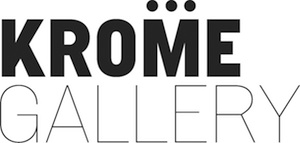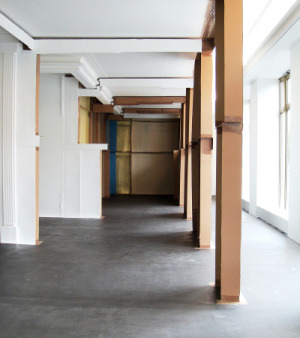•
CARLOS BUNGA
MARXITECTURE
01.05. –27.06.2009
Opening: Friday 30.04.2009, 6 – 9 pm
•
click the picture to launch gallery
•
After a diverse array of projects at KROME GALLERY, Carlos Bunga’s “Marxitecture” tackles the context of display and organization at the onset of the gallery’s regular exhibition program.
The opening of “Marxitecture” will be complemented with a 'situational' music performance by the collective AADK – Aktuelle Architektur der Kultur, outside of the gallery’s exhibition space.
“Marxitecture” is a site-specific installation that, through the use of fragile yet stabile packing material such as cardboard, seeks to produce a confrontation between the architectural exterior and its (typically) cordoned-off, detached interior space. The installation is the result of a process-oriented approach by Bunga that presents in the gallery space a paradoxical tension between, on the one hand, the seemingly ephemeral, almost trivial quality of the material in use and, alternatively, the ice-cold, majestic “eternity” embodied by Karl-Marx-Allee – the grand boulevard of Socialism. Bunga’s struc-ture allows the eye to freely adopt multiple perspectives on the distanced, vacuum-sealed representational architecture of Karl-Marx-Allee, particularly in its emphasis on the ceremonial exterior. “Marxitecture” relates principles of modular architecture and pre-fabrication, both of which display an extensive use of the grid in the tradition of the Bauhaus as well as in Socialist mass housing (the typical Berliner “Plattenbau”), transforming Bunga’s
installation into an associative, fragmentary image. The torn up and broken space, behind which patches of colored paint, the gaping cracks and the wide-open interstices visibly turn into an abstract plea for the restitution of personal history. This working method unabashedly perceives its contextual location as dialectical. If not here, then where else? Similar to the film “Themroc”, a model for the staging of a revolt arises:
“One day, the proletarian Themroc had enough of the monotonous, alienating everyday and vowed to fundamentally change his life. He resigned from his job, sent his sister away to his family, plastered his apartment door, tore down the walls facing the street and metamorphosized into a cave man, abstaining from polite colloquialisms as well as any form of recognizable speech. At first, the neighbors were shocked and then curious, finally they became altogether surprised. The State approached the situation with a mixture of complacency and amusement; at night, Themroc left his dwelling to hunt police officers for breakfast. Everywhere in the city, people began to follow his example.”
“Marxitecture” can be seen as a continuation of the diverse processes of transition present in Bunga’s work. Departing from the gradual yet complete destruction of his own paintings, his practice subsequently developed through the profanement and humiliation of paintings in the context of
public space; taking on various forms, whether it be hanging a painting on a demolished wall, its burial in a field, or the tearing of the painting’s canvas itself, Bunga has documented this process in his video works. His references are firmly rooted in performance art, specifically that of the Japanese group “Gutai”, as well as displaying an affinity to the work of artists such as
Gordon Matta-Clark and Kurt Schwitters. In “Ruin”, exhibited at Art Unlimited 2008 in Basel, Bunga reacted immediately to the monumental size and precise functionalism of the Basel Convention Center with a minimalist abstraction: a diffident floor plan of the Convention Center’s basement in cardboard offered an inverse statement on the extra-large format of
'Unlimited'.
•
Carlos Bunga (born 1976, Portugal) lives and works in Madrid and New York. In July 2009, he will be exhibiting in “Heterotopias” at the Museum of Contemporary Art in Vigo (MARCO). Bunga’s work “Ruin” was shown in 2008 at Art Unlimited in Basel. In 2007, Bunga was in the group exhibition “Unmonumental: The Object in the 21st Century”, curated by Richard Flood, Laura Hoptman and Massimiliano Gioni. At Manifesta 5 in 2004 in San
Sebastian, curated by Marta Kuzma and Massimiliano Gioni, Bunga constructed a gigantic cardboard house, only to allow it to collapse immediately.
•
On the occasion of the opening and International Worker’s Day, a performance by the collective AADK – Aktuelle Architektur der Kultur will take place. This intervention outside of the gallery space is nevertheless a specific contribution to this culturally and politically ambivalent location. Through the utilization of mismatched and recomposed music pieces from the former German Democratic Republic, Jochen Arbeit (Einstuerzende Neubauten) comments on the euphoria of socialism-turned-architecture. Vania Rovisco and Abraham Hurtado stage an abstract performance in which the female individual falls into an ensnarling confrontation with the symbolically-loaded structures on Karl-Marx-Allee. After this performance, which takes into context the historical function of Karl-Marx-Allee, AADK will additionally contribute to the Bauhaus Festival in Jena with the performance “Crash! Boom! Bau!”.

